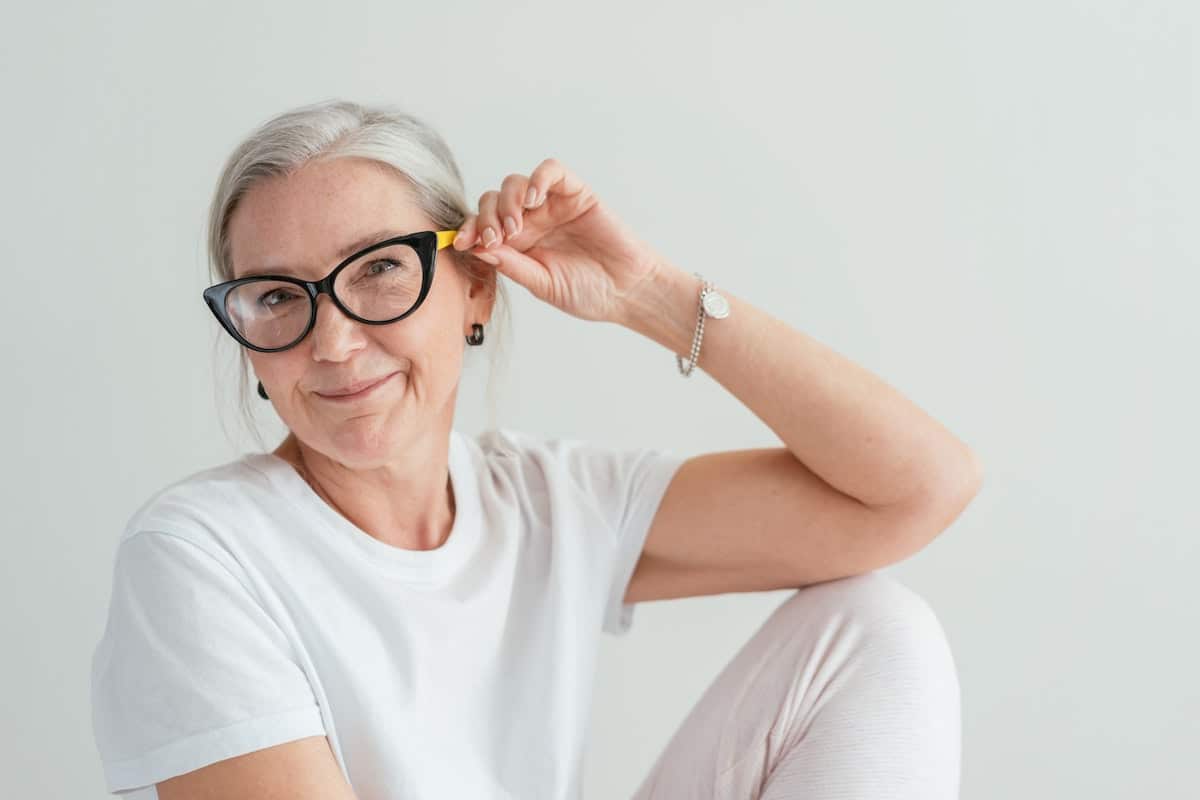Does hair grow back after 60?
At the age of 50, more than 1 in 2 women suffer from hair loss. This is what we see at Centre Clauderer. This reduction in hair mass will increase over time if nothing is done.
In fact, hair grows back even after the age of 60. But it grows more slowly, thinner and shorter. This is a result of the body's ageing process and lower levels of female hormones, which play an essential role in the vitality of hair cycle. So when these natural mechanisms are added to an area that is already sensitive to the harmful influence of male hormones (androgenetic alopecia), hair loss can accelerate rapidly and become a real suffering, often even a real source of anguish for those who suffer from it.
At Centre Clauderer, we have developed solutions to support senior women and provide a lasting remedy for hair loss. Always using natural products with no side effects and, of course, no addiction.
Here are the stories of 3 clients:
Mrs AD, aged 67
Mrs AD has published a public review on Google, which we have asked her permission to reproduce here. This review is representative of what Clauderer can offer senior women:
" My story: I'm 67 years old, my hair is limp and very fine. In October 2022, I noticed with anguish a significant loss of hair, holes on my skull (blocked washbasin and shower, pillow covered in hair) and I consulted my GP who made me do various blood tests. I then considered extreme solutions: a transplant, a wig, etc. The results of the tests were satisfactory, and my doctor recommended the Clauderer Institute so that I could use the right products for my scalp and hair. Living in Toulouse, I telephoned Clauderer and sent them some hair samples. After analysis, my Clauderer specialist recommended a treatment that I had to follow for 4 months (30 minutes of application twice a week). After a month, I noticed a clear improvement in both density and texture. After 2 months, I had my hair analysed again and persevered. My Clauderer specialist regularly encourages me. It's March 2023 and I'm very proud to show you the results I've achieved, thanks to the Clauderer method and products, as well as the encouragement of my Clauderer specialist. Thank you very much. In the photo, I also had some extensions done by a very good specialist. In short, I've come a long way... "
Mrs IR, aged 48
Mrs IR consulted the Centre Clauderer for a strong hair loss and the increasingly uncomfortable presence of dandruff and itchy scalp.
She is also taking hormone replacement therapy and is overweight.
Only one month after the start of Clauderer treatment, the The dandruff and itching that plagued Mrs IR's life have completely disappeared.
After 4 months, her hair loss had returned to normal.
Here are the microscopic results on Mrs IR's hair
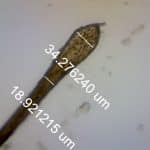
Keratin 18.92 µm
Root 34.27 µm
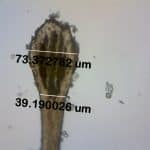
Measuring progress :
| Average thickness before treatment (in microns) | Average thickness after treatment (in microns) | Evolution | |
| Hair roots | 29 | 67 | x 2,3 |
| Hair thickness | 15 | 41 | x 2,7 |
Madame IR's hair roots have more than doubled in size in just 4 months. In concrete terms, her hair roots, which have become much more tonic and active, will in turn produce thicker, stronger hair. The thickness of Mrs IR's hair has almost tripled. This is the result of the strengthening of her hair roots. This process will grow and amplify over time.
Mrs BJ, aged 84
Mrs BJ consulted the Centre Clauderer because of a sudden acceleration in the loss of her hair mass and complained of a diffuse hair loss.
She is also being treated for high blood pressure and has experienced significant stress (loss of a loved one).
We have set up a low-impact treatment (30 minutes) to be carried out twice a week.
At the end of the programme, Mrs BJ's hair loss was normalised and her hair regained its strength.
These are the microscopic results of Mrs BJ's hair:
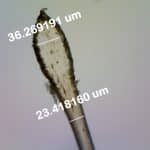
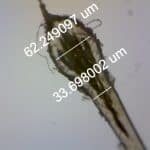
Measuring change :
| Average thickness before treatment(in microns) | Average thickness after treatment (in microns) | Evolution | |
| Hair roots | 39 | 69 | x 1,8 |
| Hair thickness | 23 | 30 | x 1,3 |
Mrs BJ's hair roots have almost doubled in size, the capacity of hair growth is visibly more dynamic. The thickness of Mrs BJ's hair was multiplied by 1.3.
How can you strengthen your hair after 60?
As we have just seen, it is very largely possible to halt the programmed impoverishment of hair after the age of 60.
In fact, the loss of hair mass that occurs is essentially the result of the slowing down of cell metabolism, in short, of ageing.
On a local level, on the scalp, we have found that it is entirely possible to put in place hair care strategies which will stimulate these processes that have become sluggish and give you more hair, less fine hair and longer hair for the long term.
At Clauderer, laits Clauderer combined with Serums Clauderer and scalp massages are the main tools used to win back hair. These simple treatments act like "gymnastics" for the scalp and hair, giving the whole more tone and vitality.
At Clauderer, we work with many menopausal women to help them solve their hair problems.
We systematically observe extremely positive results, unless they are also undergoing medical treatment that is highly damaging to the life cycle of their hair (e.g. chemotherapy).
The case of Mrs BJ, described above, shows that even after the age of 80, it is possible to halt hair loss and regain stronger, more numerous and thicker hair!
Why do we lose our hair as we age?
As we age, our hair almost invariably undergoes 4 major changes, including but not limited to hair loss:
- Gradually, hair becomes shorter and thinner:
In concrete terms, after the age of 50, the hair cycle slows down. The hair follicles responsible for hair growth become less and less active and do not remain in their active phase (hair growth phase) for as long. As a result, hair falls out more quickly (catagen phase) and does not have the time to grow as long and as strong as before. - The capillary mass becomes less important:
Generally, women do not go completely bald. However, with age, their hair can become less dense on the top and sides of the head. This reduction in hair mass affects more than half of all women over the age of 50. It can be explained by the progressive miniaturisation of hair follicles as a result of ageing. Hair grows thinner and thinner. - Hair becomes drier and more brittle:
The cause here is hormonal: after the age of 60, there is a drop in oestrogen and progesterone levels. These hormones play a very important role in regulating the sebaceous glands. As the activity of these glands diminishes, the hair is less and less 'coated' with sebum, which also plays a protective role for the hair fibre. Less sebum inevitably means drier, more brittle hair. - Hair turns grey, or even white :
Associated with hair follicles, melanocytes colour the hair as it grows. With age, the skin cells that synthesise melanin stop producing it, so the hair grows white.
Some people also associate the drop in melanin production with certain deficiencies, mainly vitamin D and iron deficiencies. More rarely, deficiencies in group B vitamins and selenium. However, the biological mechanisms behind this phenomenon have yet to be fully elucidated.
How can I stop hair loss in women?
- Cell ageing :
The most common cause of hair loss and loss of hair mass in women over the age of 50 is the slowing down of the metabolisms. Hair follicles produce less hair, for less time and with less strength. As a result, hair becomes progressively thinner, shorter and finer hair.
At Clauderer, we have developed a simple form of scalp gymnastics that combines the synergy of our natural products (Laits Clauderer, Serums Clauderer) and massages. This programme is highly effective in countering local ageing. - Nutritional deficiencies :
Sometimes, as we age, we gradually lose our appetite. This can easily lead to nutrient deficiencies. important for healthy hair. These include vitamin A, B-group vitamins (particularly B6 and B12) and, of course, vitamin C. Other nutrients are also essential for healthy hair, such as copper, zinc and iron and can quickly become deficient as a result of poor diet. In conclusion, these parameters need to be assessed and, if necessary, corrected either through the diet itself or by supplementation. - Diseases :
As women age, they are more exposed to certain chronic illnesses such as diabetes and hyperthyroidism. These diseases affect hormonal balance, which in turn affects hair health. - Side effects of certain medicines :
Many drugs are labelled as having possible adverse side-effects on hair loss. The therapeutic families concerned are mainly anticoagulants, antidepressants, beta-blockers and, of course, many chemotherapy drugs.
Don't hesitate to talk to your doctor, who may be able to find similar alternative treatments that have no major side-effects on hair loss. - Cosmetic manipulations:
These everyday gestures are often overlooked as possible causes of hair loss in older women. And yet...
For example, use a very mild shampoo with lukewarm water, use hair dryers and straightening irons at the lowest possible temperature, and avoid aggressive hair colouring as much as possible. All these simple steps will help prevent further damage to the already fragile hair of women over 60.

